
|
||
|
Portland art blog + news + exhibition reviews + galleries + contemporary northwest art
|
||
Get All That Is Coming To You / the reclamation of Lafe Pence The history of Portland is fraught with fits and starts, arbitrary decisions and long term planning. Still that history is just a construct of illustrational tales we tell ourselves about the path to now. The reality is far more complicated tales. Then there are history paintings, which can be fictional folklore reflecting civic ideals and neurosis and/or it can be embody some degree of accuracy. Also, unlike the History Painting of the past, today's artists aren't held up as verified illustrators projecting onto the present. Instead, all narratives are unreliable and most historians have approached it in this relativistic way for the past 60 years.
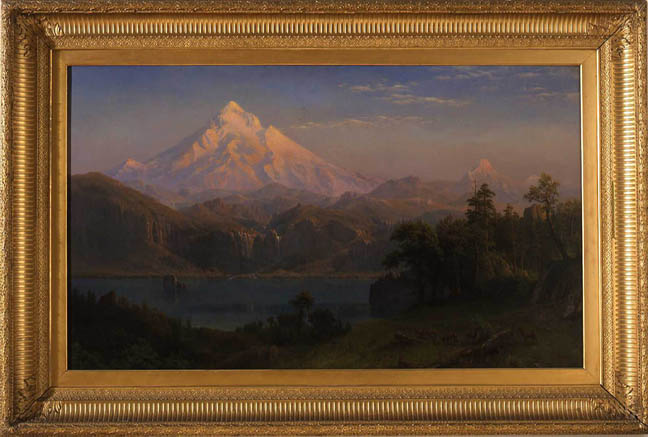 Albert Bierstadt, Mount Hood, 1869 (collection Portland Art Museum) Similarly landscape paintings are histories of existential real estate, they are always rooted at the crossroads of regionalism's often jingoistic immediacy and the ways longer jet stream winds of history are negotiated. No matter how quiescently idyllic a Constable or portentously menacing something like JM Turner's Snow Storm: Hannibal and his Army Crossing the Alps is what we see is a map of values. Psychologigist Carl Rogers would call them conditions of worth. Even a contemporary practitioner such as Anselm Kiefer, always depicts the politics and real estate intrigues of the present trying to organize the past (Kiefer purposefully paints the specific vanities of the enterprise). Overall, landscape projects existential possibilities and constraints. Even the Lascaux cave paintings are a type of political/existential document. Sometimes landscapes become popular extra-regionally, like Paris in the early Twentieth Cenntury because the landscape itself is seen as embodying the issues and idiosyncracies of a civilization in flux. Cities are nodes and littered with monuments and historical reminders. Closer to home, just look at Bierstadt's grandiose pastiches of romantic mountains... where he is fashionably trying to Alp-up the Cascades. In contrast the Alps are thrust faulted and glacial geology, the Cascades are more volcanic, glacial and diluvial in origin but Bierstadt isnt concerned with accurate so much as conveying a scene of grandeur. At the time everything was measured against the European Alps. 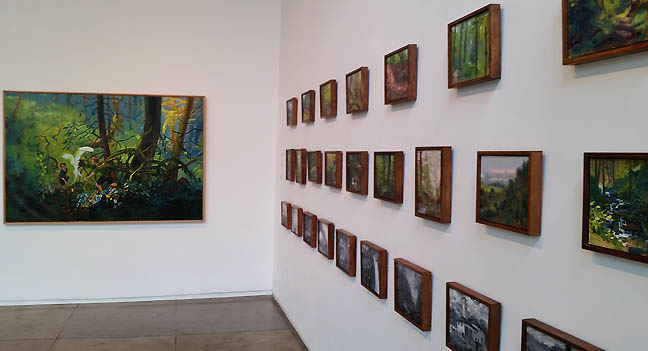 Gabriel Liston's Get All That Is Coming To You / the reclamation of Lafe Pence at Froelick Gallery Today, Portland Oregon is a kind of battleground for urban/rural land use planning in the USA. We have the urban growth boundary and Portlanders fetish innumerable small long standing neighborhoods, not massive corporate redevelopments with branding like the Hudson Yards. Yet similar to New Yorkers we obsess about how things are changing in every part of the city but what is different is that Portlanders feel enfranchised enough to influence the way those neighborhoods change. The civics of Portland are far more Romanesque, where all citizens are stake holders (it can be cacophonous). 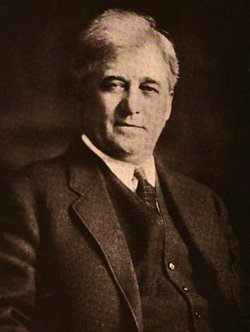 Lafayette "Lafe" Pence 1857-1923 That's why Gabriel Liston's exhibition Get All That Is Coming To You/the reclamation of Lafe Pence is an exercise in capital "R" Regionalism and lowercase history painting. By that, I mean that in choosing to create an exhibition around the controversial and disgraced Lafayette "Lafe" Pence, a Portland developer who only lived in in town from 1904 - 1907 he's picking someone of very obscure local interest and the historical content is mostly dreamily tangential. Notably Lafe himself is mostly absent except for one portrait with Huber. Gabriel Liston, Attack on Fort Moro For example the painting Attack on Fort Moro doesn't depict Sir Francis Drake's assault on the fort near San Juan Peurto Rico. Instead, it depicts fireworks over Portland's 1905 World's Fair... perhaps the single most ambitious moment in Portland's history (today many don't even know Portland ever held a World's Fair and all but a few buildings survive). The work in its own dreamy way shows the assault of 20th Century progress upon the landscape in a somewhat artificial lake... and the sense that too much of a good thing is what Portlanders today fear most. Despite our permissiveness towards individual idiosyncrasies, Portland civicly can be very prophylactic and resistant to development for its own sake. The fact that Pence was at the fair during this "golden era" of western expansions tell you what a toddling town Portland was at the time. 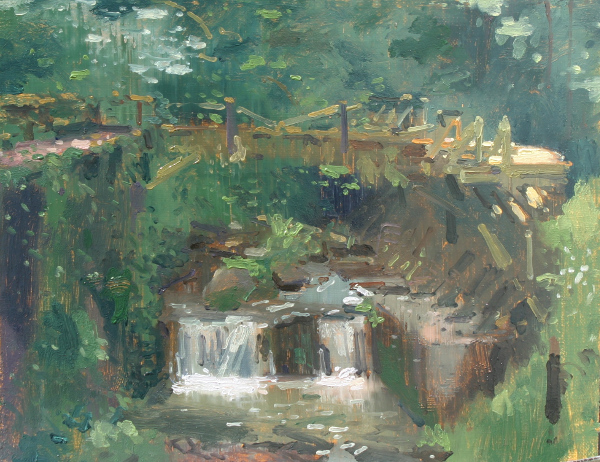 Gabriel Liston, Balch Creek Debris Trap Liston describes Pence as, "a man with too much charm, optimism, and hubris for the good of the community." Pence laid claims to water rights for the Bull Run (Portland's main drinking water source) and others in Northwest Portland (Balch Creek in Forest Park) and without permit attempted a grandiose development scheme to fill in Guild's Lake (where the world's fair was centered). L.L Hawkins a protectors of Forest Park and chairman of the parks commission saw him as, "a troublemaker from the ground up." The sluicing project was a disaster environmentally and economically and Pence soon skipped town. Thus this show about the effects of an ambitious and reckless man seems like a proscriptive parable for today's development. Today all that remains are some old sluices, foundations, a non existent lake and a placard describing Pence's tertiary ties to a murder that took place in land he owned once. 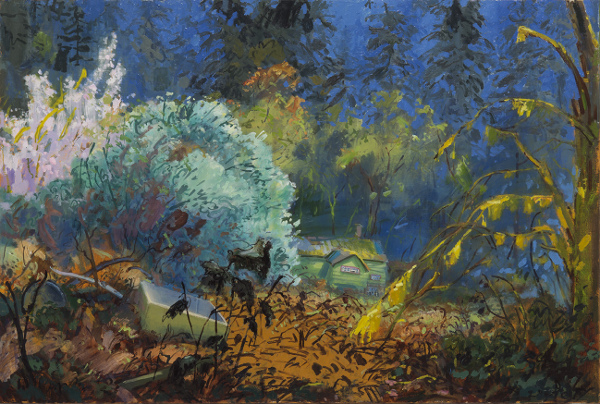 Get All That You Have Coming To You Thus, Liston's painting Get All That is Coming To You with its charmingly derelict placard (left center) telling about how Pence once owned the land at Lower Macleay Park's Upshur Street entrance and the modern day bathrooms in the distance feels a lot like the witches house from Hansel and Gretel. It was also the site of Portland's first legal hanging (long before Pence owned the land). Liston's depiction shines with erie light, like something out of a scene from Grimm. I'm not certain there is enough fairytale or history here, though I like how Liston conveys a childhood wonder upon it all. The effect makes the viewer feel sneaky, a little like something out of a Hardy Boys or Nancy Drew mystery. Liston has a Disneyfied touch to his work, I still haven't decided if I like that aspect or not but that modality keeps me coming back to it.  Experts in all Sorts of Things Another crucial piece of the exhibition is the painting, Experts in all Sorts of Things. The title is is from Mark Twain's a Connecticut Yankee in King Arthur's court... itself a comedic re-imagining of a folklore tale that is presented as a a kind of metaphorical history of England. In this case two children investigate in the environs of some of Pence's derelict sluicing infrastructure. The treatment is intentionally too saccharin... as if Liston is idealizing the youth to make the menace of the past seem more discordant. It is no secret though that Portland, more populous than it has ever been before, now has fewer children enrolled in its schools than 50 years ago. I should add that this kind of off the trail exploring degrades the habitat in Balch Creek and subtly mocks the expertise of the children... or perhaps they have a drive similar to Pence? Liston is very good at illustrating a kind of intentionally unconvincing innocence. 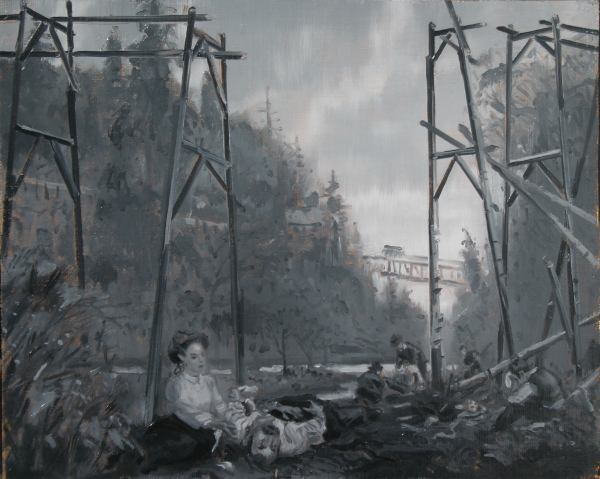
19 February 1907 The small grisaille paintings like Bruin and Lane or February 8 1907 depict a grittier history that is also a pastiche projection of places and events in the past. Today, Portland's developers tend to be more civic minded people like, Randy Rappaport, Kevin Cavenaugh, Brad Malsin, Homer Williams, Jim Winkler, Al Solheim and Jordan Schnitzer. All are very involved in the community and the visual arts. They don't act like parasites and perhaps what I like about Liston's show is the way it sneakily presents a child's kind exploratory drive as both charming and destructive. It is cautionary as we watch Portland continually grow up with some sense of trepidation and wonder but I think it reminds us that no matter how old we might appear on the outside it is human to change things just for the sake of it. Sometimes the greatest riches are being thankful for the way some things don't change... transient scoundrels like Pence who just couldn't put down any real roots in Portland included. That nostalgia is false though, things are always changing and managing that activity with imagination and utility is crucial. Mistakes will be made if we are to have exceptional things as well and like Pence Liston himself had roots in Colorado... the difference is Liston stayed here in earnest. What Liston's show begins to explore is the way Portlanders fetish and mull over the conflicting dark side and innocence of this place. It is a loaded term but that Janus like "Pioneering Spirit" is what is still so palpable in Portland... it is still unlike anything I've experienced in any other major US city. There is this sense that we are all in this together and sometimes perhaps a little too proud of it. Liston presents it as a fictional innocence, tragicomicly skewering it and perhaps hoping we aren't going to be seen like Pence in a hundred years now that Portland has become much higher profile? On View Through December 13th Posted by Jeff Jahn on November 30, 2014 at 13:12 | Comments (0) Comments Post a comment Thanks for signing in, . Now you can comment. (sign out)
(If you haven't left a comment here before, you may need to be approved by
the site owner before your comment will appear. Until then, it won't appear
on the entry. Thanks for waiting.)
|
| s p o n s o r s |
 |
 |
 |
 |
 |
 |
 |
 |
 |
 |
 |
 |
 |
 |
 |
 |

|
Site Design: Jennifer Armbrust | • | Site Development: Philippe Blanc & Katherine Bovee | |

